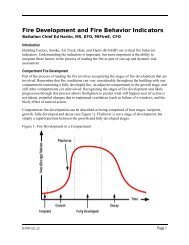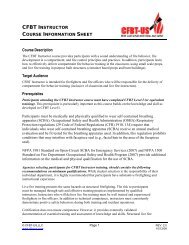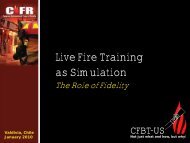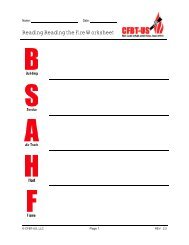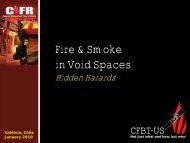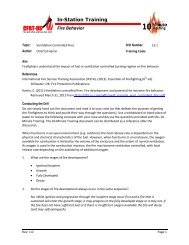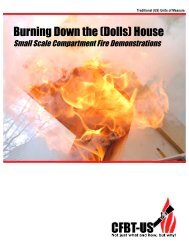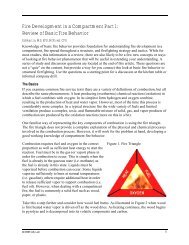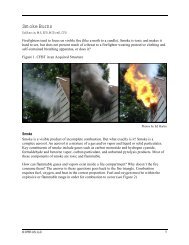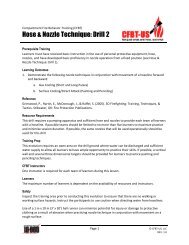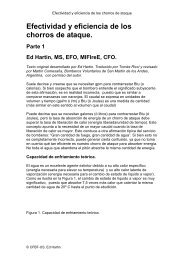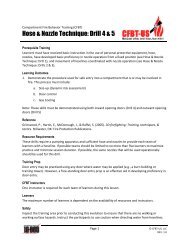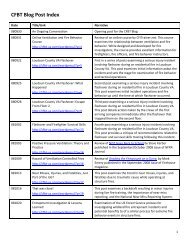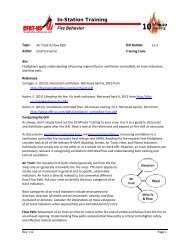3D Firefighting: Controlling the Fire Environment - CFBT-US!
3D Firefighting: Controlling the Fire Environment - CFBT-US!
3D Firefighting: Controlling the Fire Environment - CFBT-US!
Create successful ePaper yourself
Turn your PDF publications into a flip-book with our unique Google optimized e-Paper software.
Valdivia, Chile<br />
January 2010<br />
<strong>3D</strong> <strong><strong>Fire</strong>fighting</strong><br />
<strong>Controlling</strong> <strong>the</strong> <strong>Environment</strong><br />
<strong>CFBT</strong>-<strong>US</strong><br />
Not just what and how, but why!
In order to extinguish a fire properly, it is<br />
necessary for <strong>the</strong> firemen to approach it for <strong>the</strong><br />
purpose of putting <strong>the</strong> water wherever it is most<br />
wanted. Any attempt to extinguish a fire from a<br />
distance almost invariably proves a failure.<br />
<strong>Fire</strong> Protection, 1876<br />
Sir Eyre Massey Shaw<br />
Chief, London <strong>Fire</strong> Brigade
Learning Outcomes<br />
Identify and describe factors influencing<br />
effectiveness of extinguishment by cooling<br />
Describe <strong>the</strong> application of indirect attack,<br />
direct attack, and <strong>3D</strong> gas cooling
Extinguishment by Cooling<br />
Heat Transfer to<br />
<strong>the</strong> Fuel<br />
Oxidation<br />
Pyrolysis<br />
Diffusion of<br />
Fuel Vapor<br />
Cooling <strong>the</strong> fuel<br />
Cooling <strong>the</strong> gases
Temperature ( o C)<br />
Heating Curve for Water*<br />
100<br />
75<br />
50<br />
25<br />
0<br />
-25<br />
-50<br />
Phase Change<br />
Phase Change<br />
400 800 1200 1600 2000 2400 2800 3200<br />
Heat Absorbed (kJ)<br />
Boiling Point<br />
Melting Point<br />
3400<br />
* 1 kg (2.2 lbs) of Water from ice at -50 o C to Steam over 100 o C.
Specific Heat<br />
The amount of heat per unit mass required<br />
to raise <strong>the</strong> temperature by one degree<br />
Water at<br />
20 o C<br />
Specific heat applies to<br />
all states of matter<br />
Temperature<br />
Increase<br />
Ice 2.093 kJ/kg<br />
Water 4.186 kJ/kg<br />
Steam 2.009 kJ/kg<br />
Water at<br />
21 o C
Latent Heat of Vaporization<br />
The amount of heat required to convert unit mass of a<br />
liquid into <strong>the</strong> vapor without a temperature change<br />
Water at<br />
100 o C<br />
Water has a latent heat of<br />
vaporization of 2260.0 kJ/kg<br />
Phase<br />
Change<br />
Steam at<br />
100 o C
Cooling Capacity<br />
Heat required to raise <strong>the</strong> temperature<br />
of 1 kg (2.2 lbs) of water from 20 o C<br />
(68 o F) to 100 o C (212 o F)<br />
Heat required to vaporize 1 kg<br />
(2.2 lbs) of water at 100 o C<br />
Total Heat Required<br />
What happens after <strong>the</strong> water<br />
is vaporized into steam?<br />
0.3 MJ<br />
2.3 MJ<br />
2.6 MJ
Molecular Structure<br />
The dashed lines illustrate <strong>the</strong><br />
hydrogen bonds between H2O<br />
molecules as ice and water<br />
Ice<br />
Steam<br />
Water<br />
Phase Change Requires Energy to Break <strong>the</strong> Bonds
Heat Release & Flow Rate<br />
Heat Release Rate<br />
Kilowatts (kW)<br />
Megawatts (MW)<br />
Flow Rate<br />
Gallons/Minute (gpm)<br />
Liters/Minute (lpm)<br />
The higher <strong>the</strong> heat release rate,<br />
<strong>the</strong> higher <strong>the</strong> required flow rate!
Critical Rate of Flow<br />
Extinguishment Time<br />
Critical Rate<br />
Of Flow<br />
Inadequate flow rate will fail to extinguish<br />
<strong>the</strong> fire. However, increasing flow rate<br />
reaches a point of diminishing returns.<br />
Application Rate
Optimum Rate of Flow<br />
Extinguishment Time<br />
Critical Rate<br />
Of Flow<br />
Optimal Rate<br />
Of Flow<br />
Application Rate<br />
Optimal in this case is fire control with<br />
<strong>the</strong> minimum volume of water used.<br />
Volume of Water Used
Theory and Application<br />
Only a small fraction of <strong>the</strong>oretical cooling<br />
capacity can be achieved on <strong>the</strong> fireground.<br />
Actual cooling is dependent on <strong>the</strong> efficiency<br />
of <strong>the</strong> fire stream (and its use).<br />
Water is applied to cool one of four things:<br />
Hot gases<br />
Surface of burning fuel<br />
Surface of unignited, but pyrolizing fuel<br />
Surface of unignited fuel (exposure<br />
protection)
Cooling Hot Gases<br />
Hot gas layer temperature can be 600 o C<br />
(1112 o F) at <strong>the</strong> point of flashover.<br />
The temperature of flames burning in <strong>the</strong><br />
hot gas layer may be even higher<br />
Even pre-flashover, growth stage fires can<br />
result in extremely high hot gas layer<br />
temperatures<br />
Application of water fog into <strong>the</strong> hot gas layer<br />
cools and extinguishes <strong>the</strong>se flames and cools<br />
<strong>the</strong> hot gases.
Cooling Fuel<br />
Burning Fuel<br />
Application of water onto burning fuel<br />
reduces <strong>the</strong> pyrolysis rate<br />
Reduction of fuel vapor production<br />
results in extinguishment.<br />
Unignited Fuel<br />
Unignited, but pyrolyzing fuel is<br />
contributing fuel to <strong>the</strong> hot gas layer.<br />
This fuel may also be ready to ignite!
Activity<br />
<strong>Fire</strong> Stream Efficiency<br />
The efficiency of a fire stream is<br />
dependent <strong>the</strong> total amount of<br />
<strong>the</strong>rmal energy absorbed.<br />
What factors influence this process?<br />
Think about <strong>the</strong> difference between<br />
cooling hot gases and fuel surfaces.<br />
Is <strong>the</strong>re a difference in <strong>the</strong> amount of<br />
heat that can be absorbed from<br />
application of water to hot gases as<br />
compared to hot surfaces?
<strong>Fire</strong> Stream Efficiency<br />
Small droplets have greater surface area and<br />
absorb heat more effectively than large ones.<br />
A thin film of water will have a greater surface<br />
area and absorbs heat more readily.<br />
Hot surfaces will heat water to 100 o C (212 o F)<br />
Steam in <strong>the</strong> hot gas layer continues to absorb<br />
heat as vapor temperature increases.
Effective <strong>Fire</strong> Streams<br />
Put <strong>the</strong> water where it is needed (hot gases<br />
or fuel surface).<br />
Have an adequate flow rate to absorb heat<br />
faster than it is being generated by <strong>the</strong> fire<br />
An effective flow rate is dependent on actual<br />
flow rate and <strong>the</strong> efficiency of <strong>the</strong> stream<br />
Water on <strong>the</strong> floor or running out<br />
<strong>the</strong> door did not do significant work!
<strong>Fire</strong> Control Methods<br />
Direct Attack<br />
Indirect Attack<br />
Gas Cooling<br />
No method is appropriate under all circumstances!
Direct Attack<br />
Application Effect<br />
Final extinguishing process<br />
for burning fuel<br />
Technique<br />
Straight stream applied<br />
directly to burning or<br />
pyrolyzing fuel.<br />
Extinguishes <strong>the</strong> fire<br />
Cools hot surfaces<br />
Stops pyrolysis<br />
Smoke is fuel. Direct<br />
attack alone does not<br />
address this hazard.
Indirect Attack<br />
Application Effect<br />
Fully developed fire or<br />
potential backdraft<br />
conditions within a<br />
compartment<br />
Technique<br />
Medium fog pattern<br />
applied from outside <strong>the</strong><br />
compartment using long<br />
pulses to generate a large<br />
volume of steam<br />
Cools hot gases<br />
Steam displaces air,<br />
smo<strong>the</strong>ring <strong>the</strong> fire<br />
Lowers <strong>the</strong> neutral<br />
plane, worsening<br />
conditions for casualties<br />
and firefighters
<strong>3D</strong> Gas Cooling<br />
Application Effect<br />
Cooling of hot gases to<br />
provide a buffer zone in<br />
<strong>the</strong> immediate work area<br />
Technique<br />
Pulses of water fog applied<br />
into <strong>the</strong> hot gas layer.<br />
Cools hot gases<br />
Adds <strong>the</strong>rmal ballast<br />
Slows pyrolysis<br />
May raise <strong>the</strong> hot<br />
gas layer
<strong>3D</strong> Gas Cooling<br />
Application of <strong>the</strong> correct amount of water to<br />
<strong>the</strong> hot gas layer results in <strong>the</strong> following:<br />
Water is converted to steam and expands<br />
The volume of hot gas is reduced as it cools<br />
If <strong>the</strong> correct volume of water is applied <strong>the</strong><br />
hot gas layer contracts and <strong>the</strong> bottom of <strong>the</strong><br />
gas layer rises.
Nozzle Techniques<br />
Fog Stream<br />
Short Pulse<br />
Longer Pulse<br />
Straight (or Solid) Stream<br />
Penciling<br />
Painting
Pulsing<br />
Angle of <strong>the</strong> Fog Cone<br />
Maximize <strong>the</strong> volume of droplets<br />
in <strong>the</strong> hot gas layer<br />
Position of <strong>the</strong> Fog Cone<br />
As with angle, maximize <strong>the</strong><br />
volume of droplets in <strong>the</strong> hot gas<br />
layer<br />
Duration of <strong>the</strong> Pulses<br />
Sufficient to cool <strong>the</strong> gases<br />
Short Long
Nozzle Pressure<br />
150 gpm at 100 psi<br />
(567.81 lpm at 6.89 bar)<br />
150 gpm at 50 psi<br />
(567.81 lpm at 3.44 bar)<br />
Droplet size is significant!<br />
0.3 mm is optimal<br />
Size may be estimated<br />
using “hang time”, smaller<br />
droplets “hang” longer
Surface Cooling<br />
Pattern<br />
Straight stream or<br />
very narrow fog cone<br />
Force<br />
Sufficient to reach <strong>the</strong> target fuel<br />
and place water where it is needed<br />
Duration of application<br />
Sufficient to cool <strong>the</strong> surfaces,<br />
achieve extinguishment and stop<br />
pyrolysis
Key Points<br />
No one technique is appropriate under all<br />
circumstances<br />
<strong>3D</strong> gas cooling most important when <strong>the</strong> fire<br />
is shielded and hot gases are overhead.<br />
<strong>3D</strong> gas cooling is a control technique and<br />
does not completely extinguish <strong>the</strong> fire<br />
Extinguishing fires involving solid fuel<br />
generally requires a direct attack
ed.hartin@cfbt-us.com<br />
1 (503) 793-1296<br />
http://www.cfbt-us.com




